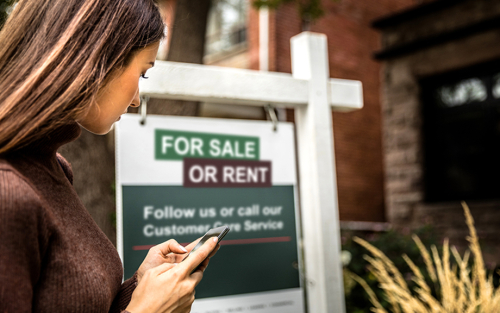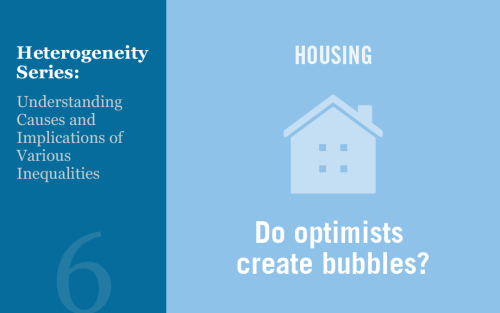Did Subprime Borrowers Drive the Housing Boom?

The role of subprime mortgage lending in the U.S. housing boom of the 2000s is hotly debated in academic literature. One prevailing narrative ascribes the unprecedented home price growth during the mid-2000s to an expansion in mortgage lending to subprime borrowers. This post, based on our recent working paper, “Villains or Scapegoats? The Role of Subprime Borrowers in Driving the U.S. Housing Boom,” presents evidence that is inconsistent with conventional wisdom. In particular, we show that the housing boom and the subprime boom occurred in different places.
Optimists and Pessimists in the Housing Market
Just Released: Press Briefing on the Evolution and Future of Homeownership
The New York Fed today held a press briefing on homeownership in the United States, in connection with its release of the 2019 Survey of Consumer Expectations Housing Survey. The briefing opened with remarks from New York Fed President John Williams, who provided commentary on the macroeconomic outlook and summarized the prospects for homeownership.
Did Tax Reform Raise the Cost of Owning a Home?

The 2018 slowdown in the housing market has been a subject of intense interest to the press and policymakers, including articles reporting a slowing in house price growth and a decline in home construction. Today we follow up on our colleagues’ research on whether the Tax Cut and Jobs Act of 2017 (TCJA) has contributed to a slowdown in the housing market, looking closely at what price signals tell us about the trade-off between owning and renting.
Is the Recent Tax Reform Playing a Role in the Decline of Home Sales?
From the fourth quarter of 2017 through the third quarter of 2018, the average contract interest rate on new thirty-year fixed rate mortgages rose by roughly 70 basis points—from 3.9 percent to 4.6 percent. During this same period, there was a broad-based slowing in housing market activity with sales of new single-family homes declining by 7.4 percent while sales of existing single-family homes fell by 4.4 percent. Interestingly though, these declines in home sales were larger than in the two previous episodes when mortgage interest rates rose by a comparable amount. This post considers whether provisions in the Tax Cuts and Jobs Act of 2017 (TCJA) might have also contributed to the recent decline in housing market activity.
The Sustainability of First‑Time Homeownership

In this post we take up the important question of the sustainability of homeownership for first-time buyers. The evaluation of public policies aimed at promoting the transition of individuals from renting to owning should depend not only on the degree to which such policies increase the number of first-time buyers, but also importantly on whether these new buyers are able to sustain their homeownership. If a buyer is unprepared to manage the financial responsibilities of owning a home and consequently must return to renting, then the household may have made little to no progress in wealth accumulation. Despite the importance of sustainability, to date there have been no efforts at measuring the sustainability of first-time homeownership. We provide an example of a first-time home buyer sustainability scorecard.
Who’s on First? Characteristics of First‑Time Homebuyers

In our previous post, we presented a new measure of first-time homebuyers. In this post, we use this improved measure to describe the characteristics of first-time buyers and how those characteristics change over time. Having an accurate assessment of first-time buyers is important given that the aim of many housing policies is to support the transition from renting to owning. A proper assessment of these housing policies requires an understanding of the impact of these policies on the share of first-time buyers and the characteristics of these buyers. Our third post will directly examine the sustainability of homeownership by first-time buyers.
A Better Measure of First‑Time Homebuyers

Much of the concern about affordable homeownership has focused on first-time buyers. These buyers, who are often making the transition from renting to owning, can find it difficult to save to meet down-payment requirements; this is particularly true in those areas where rent takes up a significant portion of a household’s monthly income. In contrast to first-time buyers, repeat buyers can typically rely on the equity in their current house to help fund the down payment on a trade-up purchase; they also have an easier time qualifying for a new mortgage if they’ve successfully made payments on a prior mortgage, thereby improving their credit score. Despite the policy focus on first-time buyers, reliable data on these buyers do not exist. In this initial post in a three-part series, we introduce a better measure of first-time buyers and examine the dynamics of this group over the past seventeen years. In our next post, we will describe the characteristics of first-time buyers. We will conclude the series by examining the sustainability of homeownership for first-time buyers.
How Is Technology Changing the Mortgage Market?

The adoption of new technologies is transforming the mortgage industry. For instance, borrowers can now obtain a mortgage entirely online, and lenders use increasingly sophisticated methods to verify borrower income and assets. In a recent staff report, we present evidence suggesting that technology is reducing frictions in mortgage lending, such as reducing the time it takes to originate a mortgage, and increasing the elasticity of mortgage supply. These benefits do not seem to come at the cost of less careful screening of borrowers.
Just Released: New York Fed Press Briefing Highlights Changes in Home Equity and How It’s Used

Andrew Haughwout, Donghoon Lee, Joelle Scally, and Wilbert van der Klaauw At a press briefing this morning, economists at the New York Fed focused on the evolution of housing wealth and its use as collateral. Their comments came in connection with the Center for Microeconomic Data’s release of its Quarterly Report on Household Debt and […]











 RSS Feed
RSS Feed Follow Liberty Street Economics
Follow Liberty Street Economics